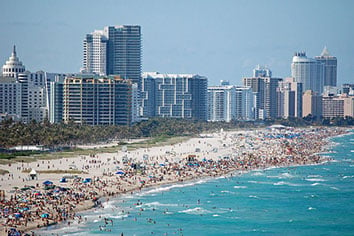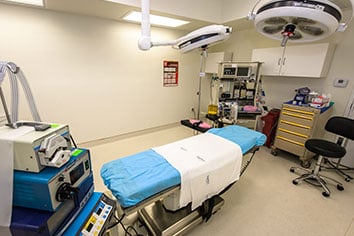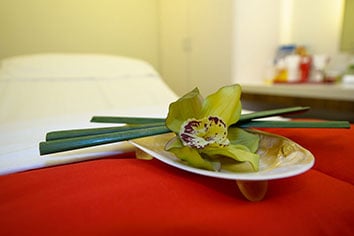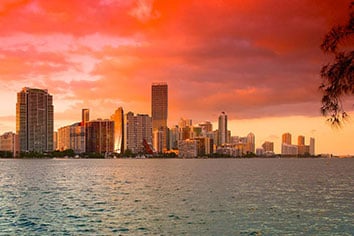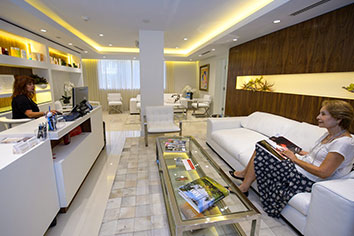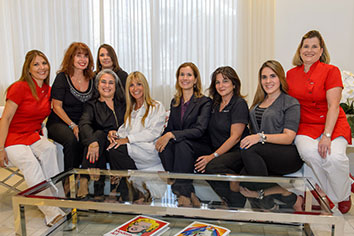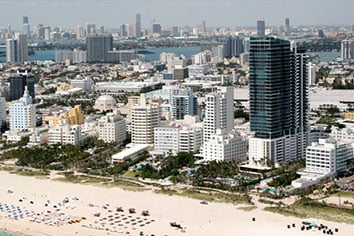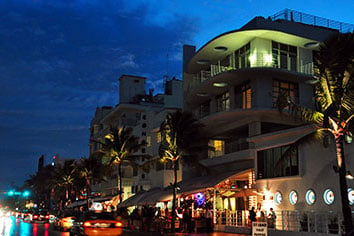Conveniently located to serve the areas of Miami and South Florida
For centuries, both men and women have been trying to maintain their youthful appearance even into their latter years. As a result, there are numerous techniques in existence for both the body and the face.
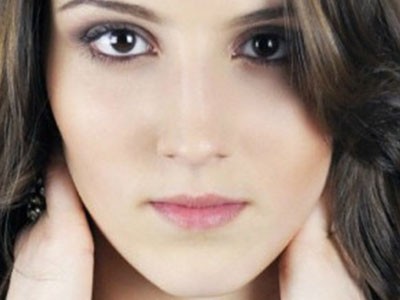
Perception of beauty encompasses worldwide standards due to ethnic conditions, geography, socioeconomic factors, lifestyles etc. Over time, the skin sags and loses its elasticity, especially around the area of the face. Common signs of aging include wrinkles, deep furrows, nasolabial fold deepening, and lip thinning, caused by the loss of subcutaneous tissue and thinning of the dermis.
Surgical and non-surgical rejuvenation treatments try to meet a patient’s aesthetic standards depending on their area of concern. Cosmetic surgery is the treatment of choice for patients requiring dramatic facial changes, however, injectable fillers are a growing solution to signs of age. Results of injectable fillers are not drastic but do create a rejuvenated, rested look. They also provide immediate results due to the fact that they do not cause swelling or inflammation. Also, many surgeons find fillers to be a complement to other procedures such as laser resurfacing or chemical peels.
Contents
History
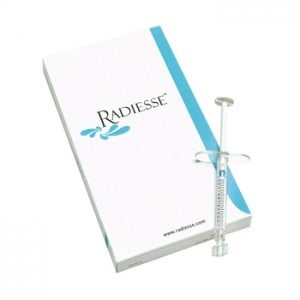
Over 100 years ago, the first materials were used for filling purposes with terrible results. Later, in 1893, autologous fat transfer was documented as a good substitute for soft tissue augmentation.
Other materials such as medical silicone were developed for augmentation as well but caused severe complications and side effects, even long after successful procedures.
Investigators at Stanford University presented a study on collagen as an injectable in the early 70s. A decade later, the FDA approved collagen for medical use, marking a breakthrough for aesthetic surgeons. This also encouraged continuing research into filler materials for the fact. Today, research has developed a number of facial filler varieties for surgeons and dermatologists to choose from.
Radiesse is one of the newest injectable substances and is best recognized for its biocompatibility and relatively long lasting effects.
What is Radiesse
Radiesse is a sterile, latex-free, non-flammable, semi-solid, cohesive sub-dermal, comprised of synthetic Calcium Hydroxylapatite, a biocompatible material found in the body that has been used in the medical field for 20 years. It is supplied in syringes and injected into the affected area for visible results including smoothing and disappearance of lines and furrows around the nose and mouth.
The material has small particles suspended in a gel-like solution. The treatment fills problem areas, plumping the skin and eliminating age lines. After three months, the particles in the Radiesse begin to stimulate natural collagen growth, causing new tissue to develop. In addition to cosmetic purposes, Radiesse can be used to treat facial lipatrophy (an HIV side effect), vocal cord deficiencies, oral and maxillofacial defects, as well as scars and chin dimples. Radiesse differs from other fillers in that it is hypoallergenic, comprised of materials naturally occurring in the human body. This also makes it the best choice among lip fillers as well. Treatments lasts an average of one year and requires less frequent injections or touchups. Though the treatment is more expensive than other dermal fillers, it does stimulate collagen production, which can have more permanent benefits. Radiesse is administered via syringe and can be saved for up to three months for future use if the entire syringe is not used in one treatment.
Candidates
Radiesse candidates are generally between the ages of 35 and 60, experiencing moderate aging signs. Treatment is often sought for smile lines, marionette lines and other facial wrinkles. Radiesse can also be used as an alternative to facial implant surgery, augmenting the nose, cheeks or chin. For more extreme signs of aging, a facelift or other procedure may prove more effective. Dr. Silvia Rotemberg can decipher the best procedure for her patients after careful evaluation. The goal is for every patient to look and feel their best and for every procedure to be safe and produce the desired aesthetic result.
Procedure
The procedure is safe and simple, with a local anesthetic being used to numb the treatment area. Performed at a doctor’s office, the injections are given under the skin into the proper facial planes needed for correction or enhancement. Radiesse is administered with the patient in a sitting or slightly reclined position. Reclining allows gravity to put pressure on the area, allowing the surgeon to see how much Radiesse is needed to fill the treatment area.
Anesthesia
Depending on the treatment area, sensitivity and medical preference, regional infiltrative or nerve block anesthesia may be used by the surgeon.
Topical Anesthesia
The most commonly used anesthesia is Betacaine, which is applied as a gel to the treatment area approx. 10-20 minutes before Radiesse injections.
Infiltrative Anesthesia
This technique has a rapid result immediately following injection. The infiltration causes the treatment area to distort, therefore treatment areas must be marked prior to injection.
Nerve Block
Nerve blocks are helpful when other forms of anesthesia may cause distortion of the treatment area or require a larger dose of anesthetic than is recommended. Because most nerves are under the skin, it is recommended that the local anesthetic be placed in a subcutaneous area using a needle.
Risks
Radiesse carries minimal risk in comparison to other elective procedures. Other injectable fillers carry a risk of allergic reaction, but due to the natural materials that make up Radiesse, there is almost no risk of any reaction. The main risk that has been associated with Radiesse is when patients allow unlicensed parties to administer the treatment. When searching for a surgeon, be sure to verify his/her credentials before undergoing any treatment. Dr. Silvia Rotemberg is a board-certified surgeon and due to her years of experience, a treatment such as radiesse would be virtually without risk for patients under her care.
Recovery
After Radiesse, slight swelling occurs around the treatment area and lasts for one to two days. Application of ice to treated area helps to reduce swelling. All normal activities can be resumed after only a few hours, but patients should minimize the use of their facial muscles for up to 48 hours following the procedure. Chewing, drinking from straws, laughing, smiling and such activities should be avoided.
Alternative Treatments
Hyaluronic Acid Wrinkle Fillers
These are the most popular kinds of wrinkle fillers, with each kind producing a slightly different result.
These injectables last for several months to over a year. Research has shown that repeated use can lead to natural collagen production within the tissues of the skin, with patients needing less filler over time to achieve similar results.
Hyaluronic wrinkle fillers include:
- RHA 2
- RHA 3
- RHA 4
- RHA Redensity
- Juvederm Voluma
- Juvederm XC
- Juvederm XC Plus
- Juvederm Volux
- Restylane
- Restylane Lyft,
- Restylane Kysse
- Restylane Refyne
- Restylane Defyne
- Restylane Contour
- Radiesse Sculptra
Collagen Wrinkle Fillers
The first wrinkle fillers were made from purified collagen extracted from cows. Although it resulted in a natural looking fill, it didn’t last very long, with injections breaking down after only one month. These fillers also had a higher risk of infection or allergic reaction due to their being comprised of animal substances.
Although new ways of processing collagen reduced allergic reaction, the results still only lasted a short time. Despite this, it is thought that collagen creates the most natural looking results. Side effects include redness and bruising at injection site along with a higher risk of allergic reaction than other injectable fillers.
Collagen injections include:
- ArteFill
- Cosmoderm
- Evolence
- Fibrel
- Zyderm
- Zyplast
Synthetic Wrinkle Fillers
These are a small category of wrinkle fillers that are comprised of lab-made substances, not including any natural elements. Synthetic fillers have side effects such as redness, swelling or bruising but can also have adverse side effects such as bumps under the skin and in rare cases, when not used by a professional, they can cause disfigurement.
Synthetic wrinkle fillers include:
- Radiesse
- Sculptra
- Silicone
Autologous Wrinkle Fillers
During this process fat is surgically removed from the patient’s thighs, buttocks or stomach and later injected into the areas needed.
This requires two separate procedures, one to remove fat and the other to inject it into a different area. Both procedures can be done in one visit. Fat purification steps are done in the lab but can be costly and time-consuming. The results of this procedure are semi-permanent but may require a series of injections spread out over a certain period.
Platelet-rich plasma injections, also known as a ‘Vampire Lifts’ are another form of autologous wrinkle filler. In this procedure, blood is drawn from the patient’s arm, purified and then injected into the face. The results of this process last only 12 to 18 months.
Because the injections are derived from the patient’s own body, there is no requirement for FDA approval.
Consult with DR Rotemberg
Dr. Silvia Rotemberg is a leading, board certified plastic surgeon operating in the city of Miami. Her technique incorporates the latest surgical advancements, combined with a vast knowledge of the foundations of plastic surgery. Whether you find yourself a candidate for Radiesse or other procedures, Dr. Silvia Rotemberg will provide a comprehensive evaluation of your goals and develop a unique treatment approach. The end result will be a more confident and youthful version of you. To schedule a consult or to find out more about Radiesse, call (305) 539-7083




